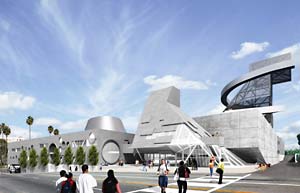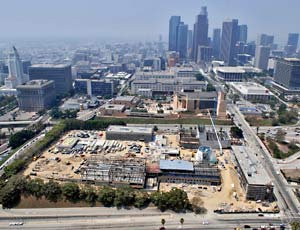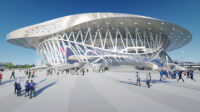With summer break finished, high school students in Los Angeles began classes again last week. But at least one facility wasn’t ready to accommodate them: the new High School #9 building, also known as the School for the Visual and Performing Arts, designed by Coop Himmelb(l)au. The eagerly anticipated project was originally scheduled to open this month but its completion has been delayed by nearly a year.


Los Angeles’s High School #9, also known as the School for the Visual and Performing Arts, was designed by Coop Himmelb(l)au. HMC Architects, based in Ontario, California, is the project’s architect-of-record. The $208-million complex was scheduled to open this month, but completion has been delayed by nearly a year due to the discovery of graves on site and the design’s complexity (top). High School #9 serves as an anchor at the northern edge of Los Angeles’ “cultural corridor” along Grand Avenue. José Rafael Moneo’s Cathedral of Our Lady of the Angels, Frank Gehry’s Walt Disney Concert Hall, and Arata Isozaki’s Museum of Contemporary Art all are located nearby (above).
At 238,000 square feet, High School #9 encompasses 64 classrooms within seven buildings, serving 1,728 students in four distinct academies: music, theater, dance, and visual art. Each academy is dedicated to a specific discipline and features its own studios, offices, classrooms, and workrooms. There is a shared gymnasium and cafeteria, with a library occupying a canted, cutoff cone that points skyward—symbolizing, its architects say, “the space of knowledge.”
Several factors led to construction delays, according to Samantha Koos, a spokesperson for the Los Angeles Unified School District. Early on, crews unearthed graves at the 10.26-acre site, which was occupied by the historic Fort Moore during the Mexican-American War. This discovery resulted in a time-consuming excavation, conservation, and relocation process. But the $208-million building’s complicated design, by the Vienna-based architect known for its challenging forms, took more time to execute than anticipated.
“This is the most complicated, difficult projects that we’ve ever undertaken,” Koos says, adding that the school district budgeted $9.48 million for the cost of creating construction documents. “Due to its unique, unorthodox architecture, it’s unlike anything we’ve ever done before.”
The plan features a main entrance, along the Grand Avenue facade, consisting of a large outdoor plaza and staircase. A glass-and-steel, crystalline-shaped lobby leads to a 1,000-seat theater which rises into a slanted tower encircled by a spiral ramp topped with 3,500 square feet of exhibition, conference, and event space. The tower is conceived as a symbol for the city’s arts scene. Classrooms occupy a series of sloped rectangular buildings that frame the site, with large porthole-like windows peering outward. HMC Architects, based in Ontario, California, is the project’s architect-of-record.
With its bold forms and high profile design team, High School #9 serves as an anchor at the northern edge of Los Angeles’ “cultural corridor” along Grand Avenue. José Rafael Moneo’s Cathedral of Our Lady of the Angels, Frank Gehry’s Walt Disney Concert Hall, and Arata Isozaki’s Museum of Contemporary Art all are located nearby.




Post a comment to this article
Report Abusive Comment